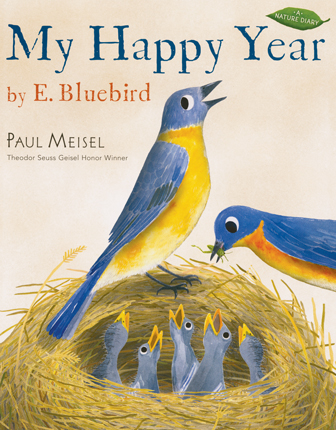| My happy year by E. Bluebird (Nature diary) Author: Meisel, Paul | ||
| Price: $6.50 | ||
Summary:
Narrative non-fiction, in journal form, relates the first year in the life of an Eastern bluebird.
| Accelerated Reader Information: Interest Level: LG Reading Level: 2.20 Points: .5 Quiz: 501745 | Reading Counts Information: Interest Level: K-2 Reading Level: 2.40 Points: 1.0 Quiz: 76681 | |
Reviews:
Kirkus Reviews (12/15/18)
School Library Journal (03/01/19)
Booklist (12/15/18)
The Hornbook (00/05/19)
Full Text Reviews:
Booklist - 12/15/2018 Like its companion book, My Awesome Summer, by P. Mantis (2017), this volume is called A Nature Diary. In dated entries, a bluebird records her experiences during her first year. On June 1, she hatches and opens her beak to be fed. Over the next few days, she is able to hear and then see her siblings. They eat bugs and grow feathers. One of the fledglings leaves the nest and flies to a nearby branch. Soon all the young birds take wing. In October, they fly to a warmer place, returning in March. The bluebird now finds a mate, builds a nest, and lays five eggs that hatch in early June, bringing the story full circle. Created with acrylic ink and digitally enhanced, Meisel’s handsome artwork shows a strong sense of color and form in depicting the natural world. The larger scenes are particularly striking. In the text, a simply written narrative traces the bluebird’s growth from chick to mother bird, while illustrated notes offer additional facts. A clearly presented, informative introduction to a bird’s life cycle. - Copyright 2018 Booklist.
School Library Journal - 03/01/2019 Gr 2–4—It is E. Bluebird's birthday! E. is an Eastern Bluebird, and this story takes readers through a year in her life beginning at day one. When E. and her siblings hatch, they cannot see and must rely on their mother for food. As they grow, their eyesight improves and they begin to grow feathers, and eventually become more comfortable striking out on their own. Will E. be brave enough to leave the nest in time for her family's great migration? Short sentences, large text, and bright, vivid illustrations engage readers, whether bluebirds are familiar to them or not. Though it is nonfiction, the work reads as fiction for an early reader due to the design, word choice, and sentence length. A spread at the beginning provides more detailed information about bluebirds and serves to introduce children to the real animals upon which this story is based. VERDICT An excellent addition to library nonfiction sections that provides an enjoyable option for emerging readers who prefer reading more factual literature.—Mary Lanni, Denver Public Library - Copyright 2019 Publishers Weekly, Library Journal and/or School Library Journal used with permission.



